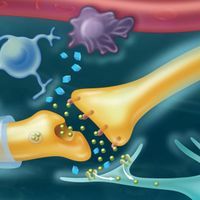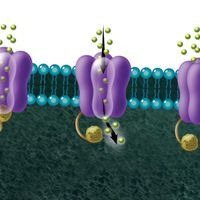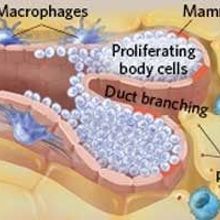Login
Subscribeneuroscience, cell & molecular biology

Glial Ties to Persistent Pain
Mark R. Hutchinson | Jan 1, 2018 | 10 min read
Immune-like cells in the central nervous system are now recognized as key participants in the creation and maintenance of persistent pain.

Targeting Sodium Channels for Pain Relief
Catherine Offord | Jan 1, 2018 | 10+ min read
The race to develop analgesic drugs that inhibit sodium channel NaV1.7 is revealing a complex sensory role for the protein.

Infographic: Two Pain Paths Diverge in the Body
Mark R. Hutchinson | Dec 31, 2017 | 2 min read
The acute pain that results from injury or disease is very different from chronic pain.

Infographic: A Painful Pathway
Catherine Offord | Dec 31, 2017 | 2 min read
Since the mid-2000s, the voltage-gated sodium channel NaV1.7 has emerged as a promising target for a new class of analgesics.

Opinion: How to Define Cell Type
Fred H. Gage, Sara B. Linker, and Tracy A. Bedrosian | Nov 1, 2017 | 4 min read
Advances in single-cell technologies have revealed vast differences between cells once thought to be in the same category, calling into question how we define cell type in the first place.

Getting Drugs Past the Blood-Brain Barrier
Amanda B. Keener | Nov 1, 2017 | 10+ min read
To treat neurological disease, researchers develop techniques to bypass or trick the guardian of the central nervous system.

Infographic: Breaking into the Brain
Amanda B. Keener | Oct 31, 2017 | 2 min read
The blood-brain barrier is a collection of specialized cells and proteins that control the movement of molecules from the blood to the central nervous system.

Harald Janovjak Bends Cells and Receptors to His Will
Aggie Mika | Oct 1, 2017 | 3 min read
The 38-year-old synthetic biologist comes from a long line of tinkerers and engineers.

Microglia Turnover in the Human Brain
Shawna Williams | Oct 1, 2017 | 2 min read
Researchers find that about a quarter of the immune cells are replaced every year.

Motor Man
Anna Azvolinsky | Sep 1, 2017 | 9 min read
Ron Vale has spent a career studying how molecular motors transport cargo within cells. He’s also developed tools to help scientists communicate their findings.

Gut Feeling
Ruth Williams | Jun 22, 2017 | 3 min read
Sensory cells of the mouse intestine let the brain know if certain compounds are present by speaking directly to gut neurons via serotonin.

Cortical Interneurons Show Layer-Specific Activities
Ruth Williams | Mar 2, 2017 | 3 min read
Researchers examine the firing patterns of interneurons throughout all layers of the somatosensory cortices of alert mice.

Bacterial Protein Acts as Prion in Yeast and E. coli
Jef Akst | Jan 16, 2017 | 2 min read
Clostridium botulinum produces a transcription factor that can aggregate and self-propagate a prion-like form, leading to genome-wide changes in gene expression in E. coli, according to a study.

Researchers Refute Proposed Neuron Migration Pathway
Jef Akst | Jan 10, 2017 | 2 min read
A team of scientists was unable to replicate controversial, high-profile findings published in 2011.

Neuron Signaling Persists, Faintly, Even When Key Presynaptic Proteins Are Absent
Ben Andrew Henry | Nov 1, 2016 | 2 min read
Results from experiments in mice revise a long-held hypothesis that certain protein scaffolds are needed for synaptic activity.

Thirty Years of Progress
The Scientist | Oct 1, 2016 | 1 min read
Since The Scientist published its first issue in October 1986, life-science research has transformed from a manual and often tedious task to a high-tech, largely automated process of unprecedented efficiency.

Circadian-Controlled Thirst
Ruth Williams | Sep 28, 2016 | 3 min read
Scientists determine how the brain’s central clock regulates drinking prior to sleep in rodents.

Facebook CEO’s Donation a Boon to Basic Science
Kerry Grens | Sep 25, 2016 | 1 min read
But can $3 billion dollars meet the lofty goals of the Chan Zuckerberg Initiative?

Next Generation: Nanotube Scaffolds Reconnect Spinal Neurons
Ruth Williams | Jul 15, 2016 | 3 min read
A 3-D carbon nanotube mesh enables rat spinal tissue sections to reconnect in culture.

Immune Cells' Roles in Tissue Maintenance and Repair
Jeff Biernaskie, Sarthak Sinha, and Waleed Rahmani | Jun 30, 2016 | 1 min read
The cells of the mammalian immune system do more than just fight off pathogens; they are also important players in stem cell function and are thus crucial for maintaining homeostasis and recovering from injury.